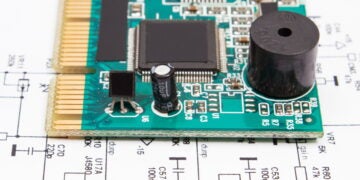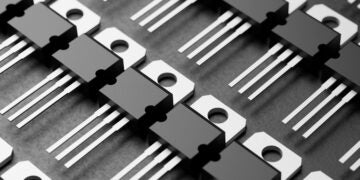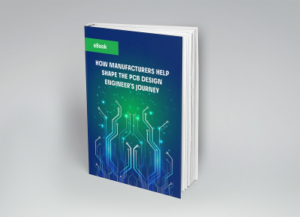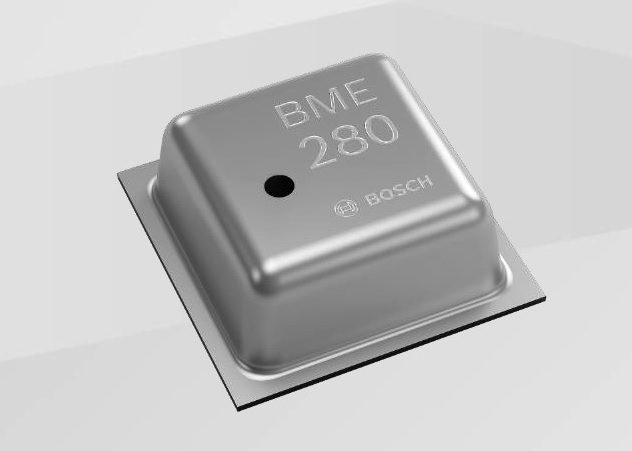
BME280 multifunction sensor
Most of us can remember the days when a watch was, well, a device to keep track of time. You know, so you would not be late for a particular professor’s class and maybe miss a pop quiz. Although, they do still make those, for today’s wearables keeping track of time is not a primary function. Instead, health and wellness applications are driving the demand and development of wearable technology.
As with most other products, circuit boards and electronic components are the keys to providing the enhanced functions and capabilities that have transformed the simple wristwatch into an advanced technological device for improving your physical well-being. Primarily, sensors are used to gather data and/or information that help you monitor your fitness everywhere you go. As described in the BME280 datasheet, this is the major application for this advanced combined sensor.
The Sensor-Driven Wearable Technology Evolution
More and more our quality of life is tied to the level of ambient intelligence (AmI) of the environments in which we spend our time. And the synergy necessary to create the most ambient surroundings for us is based upon the functionality and capability of the electronic devices utilized. This includes computers, smart appliances, cellular phones, and wearables.
Although, not often thought of as such, eyeglasses–which have been around for centuries–are wearable technology. What we commonly describe as wearables today can be traced to the 1970s with the introduction of calculator wristwatches. However, since the turn of the century this technology has exploded and is now commonplace, especially as a means of monitoring and improving physical fitness and health.
The success of wearables is inextricably linked to electronic sensors. There are many different types of sensors which are incorporated into wearable products. These include thermal, electromagnetic–capacitive or inductive–, direction–gyroscopes–, pressure, and humidity sensors. These sensors are typically small, provide reliably accurate measurements, and are durable. A good example is the BME280 sensor, which collects data for three different environmental parameters.
|
BME280 SENSOR PARAMETER MEASUREMENTS |
|
|
Parameter |
Applications |
|
Pressure |
Fitness monitoring, weather forecasting, positioning and awareness |
|
Humidity |
Home automation, weather forecasting, skin detection |
|
Temperature |
Weather forecasting, home automation |
Although, a multi-sensor device, the BME280 comes in a 2.5mm x 2.5mm x 0.93mm LGA. The component has great accuracy ratings across all three measured parameters, covers a wide operational range, and lends itself to stable and reliable performance over its lifecycle.
The Combined BME280 Temperature, Pressure and Humidity Sensor
The Bosch BME280 is a multi-functional high-performance sensor system. There are sensors that combine measurements; such as heart rate and blood pressure; however, the BME280 component combines the ability to measure temperature, humidity and pressure in a single component package. A small size, and low power requirements–which enables standalone battery power supply usage–make the BME280 an excellent choice for wearable and other applications, as described in the BME280 datasheet.
Applications and Specifications
The BME280 is commonly deployed in a number of applications that support AmI and user wellness, as listed below.
Typical BME280 Applications
- Fitness and wellness monitoring
- Indoor and outdoor navigation
- GPS improvement
- Context awareness
- Home automation control
- Sports activities
- Vertical velocity
The sensor is a low power, low current consumption device irrespective of operation and has the following electrical characteristics.
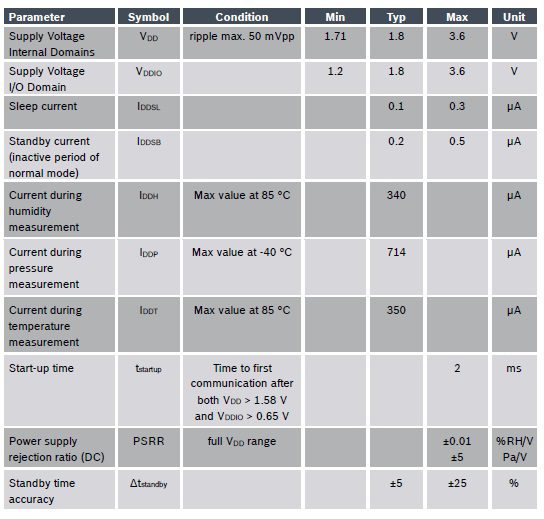
BME280 electrical specifications
As indicated in the table above, the sensor operates on a maximum supply voltage of 3.3 V, which means that many batteries; including thin profile coins will adequately run these devices. It is also noteworthy that the highest current rating of 714 µA occurs during pressure measurements. Other important pressure parameters are listed below.
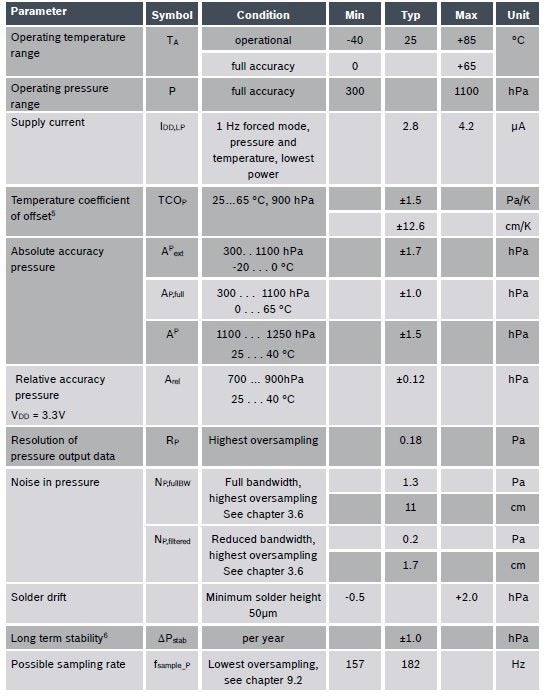 Pressure parameters
Pressure parameters
As shown above, the BME280 has accuracy in the range of ±1.0 to ±1.7 hPa over its approximate pressure measurability temperature range (-25 to 65 °C) and has a yearly stability rating of ±1.0 hPa. For humidity, as shown in the table below, the yearly stability rating is 0.5 %RH (relative humidity). 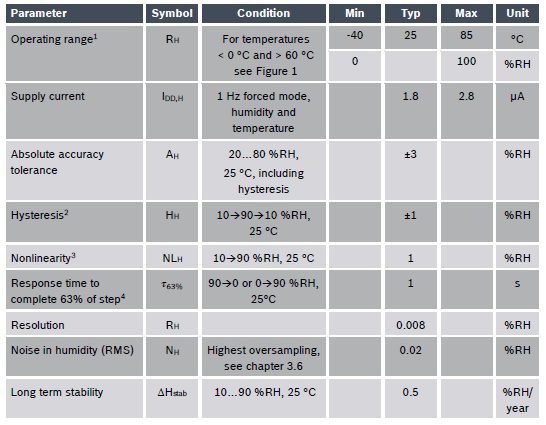
Humidity parameters
The operational temperature range of the BME280 is -40 to 85 °C. For temperature measurements, the range is (-20 to 65 °C) and accuracy is between ±1.0 to ±1.5 °C as shown below.
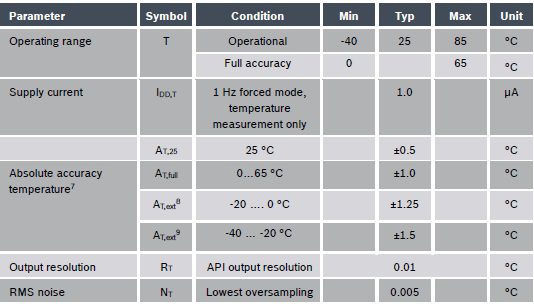
Temperature parameters
Architecture and Operation
The BME280 datasheet also provides detailed information about the sensor’s structure and operation. A block diagram, below, shows the major subsystems for the device’s three function measurement capability, as well as types of interconnectivity.
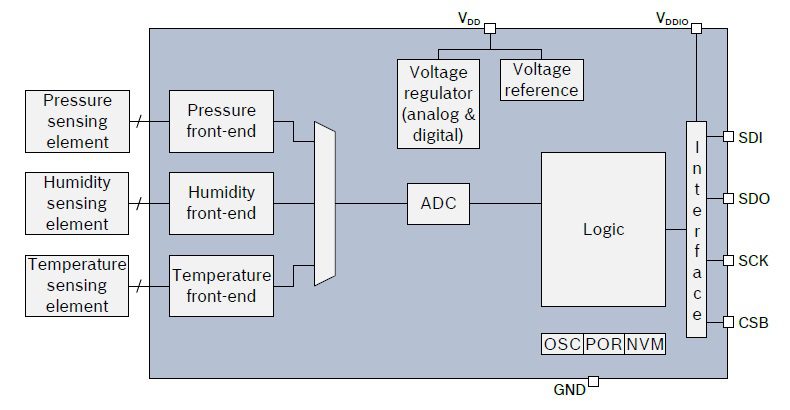
BME280 function block diagram
The BME280 may be operated in one of three modes:
Operation Modes
- Normal – Continuous cycling between measurements and sleep intervals.
- Forced – a single measurement is taken, and the device goes into sleep mode.
- Sleep – no measurement activity.
For modes 1 and 2, measurement activity proceeds as illustrated below.
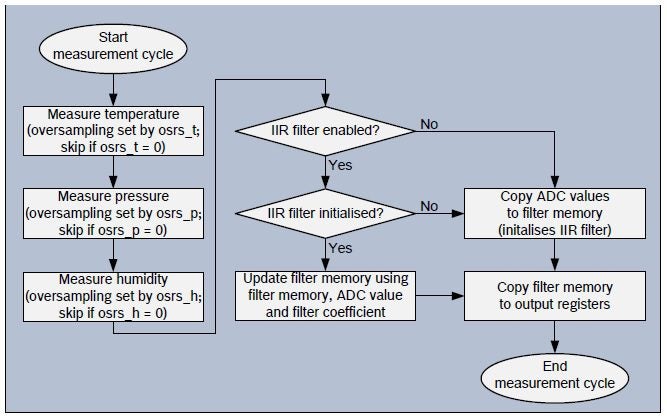
BME280 measurement cycle flowchart
As shown above, the BME280 employs the same paradigm for single and continuous measuring. This makes utilizing the device extremely straightforward for any mode of operation.
How to Best Utilize the BME280 Datasheet for PCBA Design
The BME280 datasheet is filled with details on the sensor’s operation. This includes a section on recommended operations which explains how to set up the device for optimal functioning to monitor the weather or just humidity. Additionally, suggestions for gaming and indoor navigation are covered.
When designing PCBAs that utilize the BME280, it is important to leverage the wealth of information from the datasheet. However, it is equally critical that you rely on accurate CAD data; such as shown below, from a reliable component information source.
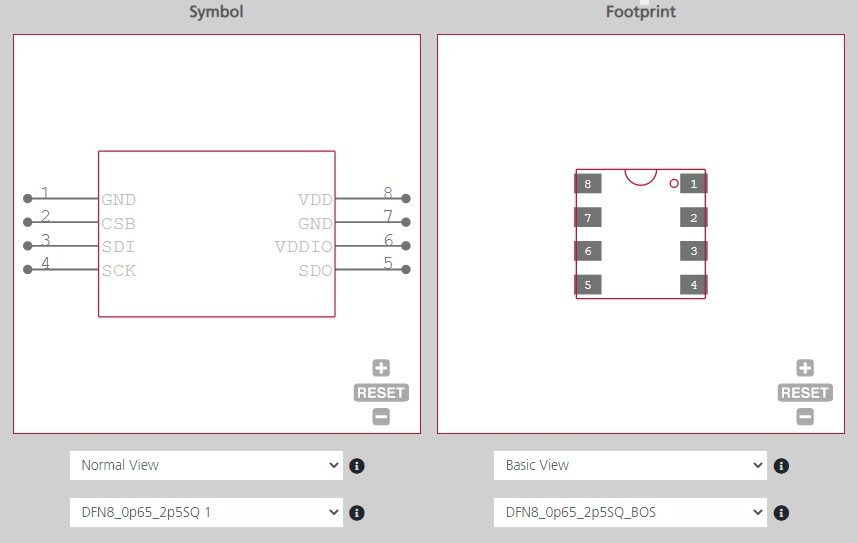
BME280 symbol and footprint
If you’re looking for CAD models for common components and design information; such as presented in the BME280 datasheet, Ultra Librarian helps by compiling all your sourcing and CAD information in one place.
Working with Ultra Librarian sets up your team for success to ensure streamlined and error-free design, production, and sourcing. Register today for free.


